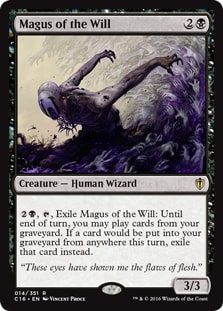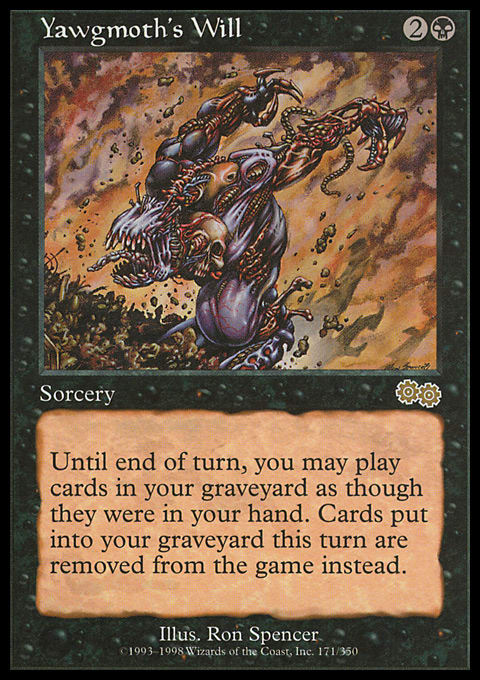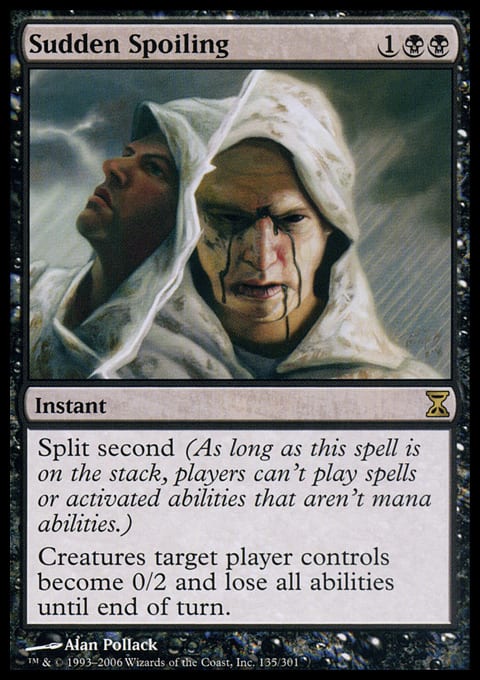It shouldn't come as a surprise, given that my first article here at Gathering Magic was on a character almost two decades old (holy crap!), that I liked a lot of Time Spiral block. It was, after all, a "nostalgia block," a block that promised to dig deep into Magic's history. At its best, Time Spiral produced cards that were dense and compelling from a storyline perspective, relying on reference and homage to communicate new ideas. Time Spiral didn't always manage to hit this high water mark, of course, and some flavor and storyline decisions of the period — most notably the Mending — were, let's say, a little divisive. Nevertheless, while we don't necessarily want another Time Spiral Block for a whole host of reasons, the good work Time Spiral did — and anything that makes the past of Magic more visible is doing good work, I'd say! — is now being carried out in products like Commander.
It's easy to see this in Commander's new legends based on older characters. Teferi. Freyalise. A better representation of Feldon than I would have ever dreamed of getting. And, joining these hallowed ranks in Commander 2016, Sidar Kondo, a character that many will greet with, "Wow. Huh. Who?" and others will greet with, "That's a . . . hell of an ability there. And I guess we still do Flanking? Wow. Huh."
This is not going to be an article on Sidar Kondo though, which leaves this article in a weird place. After all, we got a lot of new characters in Commander 2016, and a bunch of folks who made cameos in recent Uncharted Realms pieces, and . . . not really anything else pre-Mending besides Kondo. If you're looking at legend cards alone, it's hard to see how Commander 2016 pays homage to the old storyline, Time Spiral-style.
Legends, however, aren't the only way Magic can bring the stories of the past into the future, and Commander 2016 has one card that might make up for the lack of older legends. Interestingly enough, it's a card that itself hearkens back to Time Spiral itself: Magus of the Will.
Now, this card is doing a lot of flavor work in a limited amount of space, as all cards must, and it's worth looking at from that perspective. Let's start with the basics. Magus of the Will is a continuation of the three Magus cycles in Time Spiral. The Magi all reproduced in some way an ability from famous (read: busted as hell) cards in Magic's past on softer bodied creatures. So Magus of the Will is a callback to cards that are . . . callbacks to other cards.
In fact, really every Magus is related to the others — the first five are related to each other as a horizontal cycle — so we make the connection across the cards that way, then the subsequent cycles are connected horizontally, and connected to the previous cycles. This is underscored by the themes of the cards: the first cycle drew their inspirations from artifacts, the second from lands, and the third from enchantments. This new Magus is, inevitably, related to the others, for those familiar with them. This is pretty simple stuff — basic pattern matching. If you have the pieces of information in front of you, you will presumably be able to parse out the connection, which is what makes cycles so great for Magic's design.
Magus of the Will, like the others, also calls back to a (broken) card from Magic's history: Yawgmoth's Will. Suffice to say, in terms of powerful cards deserving the Magus treatment, it's hard to go wrong with the Will, a card banned in many formats, bearing the name of the dark Father of Machines, false god of Phyrexia. Interestingly, this Magus departs from the others by picking a broken sorcery rather than an enchantment, land, or artifact. Mechanically it's pretty much a straight pull from the original card: same mechanics and same mana costs, fused mercifully onto a squishy wizard body.
Where this card really takes off is Vincent Proce's art, though. This is great stuff visually, a direct callback to the original card that replaces the biomechanical monstrosity rending a cancerous earth with a human wizard rending a . . . bunch of . . . hands? Yeah this is a bit on the weirder side, which is honestly great. I'm a huge fan of more abstract or conceptual Magic art, and there's something delightfully creepy about an amorphous stream of just hands kind of erupting from the ground.
There's something really wonderful as well (and by wonderful I mean awful) about the translation of the original art's pose onto a human form. The original creature on Yawgmoth's Will was animalistic, brutish and brutal and holy crap I never noticed before that it's actually got a skull kind of jutting impudently out of the side of its face. It is an abominable carrier of the will of the Father of Machines.
This Magus, meanwhile, is a human who has willingly taken up his predecessor's task and forfeited humanity in the process.
This is where we start to move beyond merely pattern-matching and start to actually read the card. Reading isn't just decoding the information in front of us. Rather, at least according to the reader-response model of criticism that I tend to subscribe to, we work with what's in front of us and make connections in part by filling in gaps with our own knowledge. My point here isn't to parse out where pattern matching ends and reader-response criticism begins — that seems pretty boring and rules lawyery to me honestly. Rather, what I'm interested in is the way that this card presents us with a bunch of informational cues — almost overloads us with the cues in fact — and then lets us fill in the rest for ourselves.
Magus of the Will is almost a little bit overdetermined semiotically (meaning, in terms of the different signs that it offers us). You've got a pretty solid chance of figuring out what you're looking at if you run across either the other Magus cards or the original Yawgmoth's Will card, which can all be accessed through name and through mechanics. It's pretty easy, I think, to stumble upon that information. Yes, we get it, Magus of the Will, you're really really into that one spell from Urza's Saga.
Parsing out the interesting stuff about the pose, though, takes some other knowledge of Magic's storyline. Let's take a look at the mask our friend William (that's his name, it was confirmed by Brady Dommermuth at some point, trust me) is wearing. This mask most famously appeared as the Apocalypse logo, and alongside the circle bisected with a vertical line it is the best known symbol of Phyrexia. After the Invasion there was a lot of this kind of Phyrexia-stamped detritus around — we can see it, and maybe a result of Phyrexian experimentation, on Barbarian Outcast, for example. There's a high likelihood that this Magus scavanged the mask on Dominaria itself, or on another of the planes tainted by Phyrexia prior to the Invasion. After all, the New Phyrexians worship a new Father of Machines and have abandoned Yawgmothian iconography.
But the Mask of the Ineffable emerged on Dominaria in a more sinister way, a way that makes me confident in describing this as a Dominarian character: people living in the lands touched by Yawgmoth's presence have a habit now of oozing black ichor from their eyes. That puts the flavor text in a disturbing new light. Just how far has this ichor-weeping progressed for this person? The fact that we can't see his face only makes this more unnerving.
We're heavily in the realm of inference now, putting the pieces together and introducing our own knowledge in order to draw conclusions about what this card means. What do I think it represents? Well, what I bring to the table, my "repertoire" in reader-response terms, helps me fill in a story about Dominaria after the end of the world. This is a world savagely scarred by the Invasion, damaged further by a long history of conflicts, a world only beginning to heal. In that context, is it surprising that some mages, touched by the dark legacy of Yawgmoth, might attempt to resurrect the Lord of the Waste's teachings? Might the Phyrexian scriptures*, which described The Ineffable as a god-man who remade himself, died, and rose again as an ultimate being, have survived the Apocalypse and fallen into the hands of human devotees? This, to me, is a compelling and troubling narrative of a turn to dark history in response to present crisis, the recurring nightmare of Phyrexia still haunting Dominaria.
*J Robert King describes these scriptures at length in the short story "Phyrexian Creations"
There's some dense stuff here, then, for anyone interested in cards-as-story. This card goes beyond just providing a callback, a pat on the head for old fans. I mean, even that is always nice, I'm not going to complain about being pandered to every once in a while. But this is more than pandering, it's rewarding for those invested in the storyline long-term because it allows us a fruitful glimpse into post-apocalyptic Dominaria.
And maybe most cleverly of all, it does it by playing on our own nostalgia. Think about it: if we're inclined to read this narrative as someone bringing Phyrexian beliefs back into the world, even if it means exiling himself from reality (in mechanical terms) in order to consciously carry out, to cast, Yawgmoth's Will . . . doesn't that fanatical excitement at the return of Phyrexia resonate with those of us excited by this card? Are we really that different from the Magus of the Will, still enthralled even after Yawgmoth's defeat with the power that Phyrexia offers? The Magus cards translate a possible lived experience of excitement at the return of old cards into narrative terms by creating characters who are, themselves, fixated on ancient magic. If the Magi suggest a narrative, it is because we bring our own lived experience with Magic's history and translate metatext back into story text.
That's a lot of work done by one card, if our eyes are open to seeing it.




























